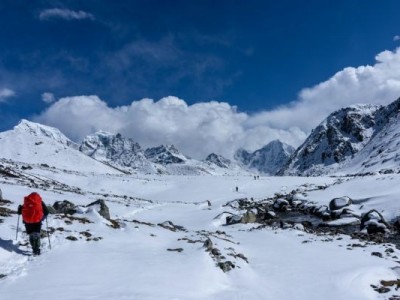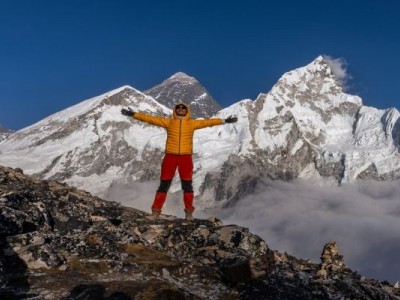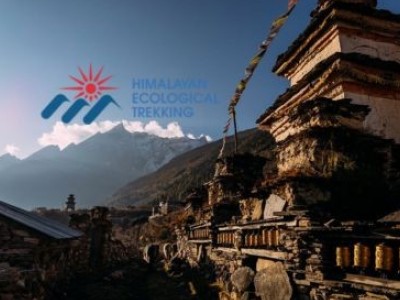The Summer Langtang Valley Trek presents an exceptional experience exploring one of Nepal's most picturesque Himalayan valleys during the monsoon months. Trekkers, out of habit, skip the summer season, but if trekkers find themselves in the Langtang region from June to August, there is an alternative experience of this magnificent area. During the summer months, vibrant wildflowers line the trails, waterfalls pulse down the mountainsides, and the valleys are alive with verdant vegetation that encompasses the landscape in colorful foliage. The Langtang Valley trek in the summer provides a unique opportunity to experience Nepal’s natural landscape at its peak—and with fewer people on the trails, trekkers will feel more intimate with the scenery. Beyond the precipitation associated with the monsoon season, a trek in the Langtang Valley provides opportunities to experience the natural beauty of Nepal in a different light. Of course, trekkers will face situations with slick trails as well as afternoon rain showers, but the summer experience is far more rewarding for those who are prepared for an authentic Himalayan experience.
Table of Contents
Why is Summer the Best Time to Trek in the Langtang Valley Trek?
In summer, the Langtang Valley becomes a paradise for naturalists. The monsoon rains rejuvenate the valley, creating an opportunity that many trekking enthusiasts consider this area’s finest time to visit.
The primary benefit of trekking in summer is abundant biodiversity. The alpine pastures flood with colorful rhododendrons, primulas, and countless flowering wildflowers that only bloom in the monsoon months. The forests are stunningly green, with dense canopy coverage, providing natural shade on your trek.
Wildlife viewing is meaningfully improved in the summer as animals become more active and visible foraging in the abundant vegetation. You are more likely to see red pandas, Himalayan black bears (at a distance), and the myriad bird species that migrate to the valley during this time.
In the summer season, there are significantly fewer travelers wandering about compared to the busy spring and fall seasons. Teahouses will feel less crowded, and trails will be quieter. You can expect to have a more enjoyable experience trekking as there will be fewer groups. This means you can spend more time immersed in the culture of the local Tamang people, who may have more time to share their customs and traditions with guests.
Waterfalls flourish the most during summer. The amount of rain will produce hundreds of temporary and permanent waterfalls tumbling down cliff faces that create a constant force of rushing water along the way. The Langtang Khola River will be swollen from the glacial meltwater, contributing to the excitement of the scenery.
Photography is very rewarding in the summer months. Dramatic cloud formations, misty mornings, vibrant flowers, and incredible lighting create some of the best opportunities for photography, respite for a few of the drier months.
- Article you may like it: Best Time to Trek Langtang Valley: A Complete Seasonal Guide
Summer Seasons for the Langtang Valley Trek
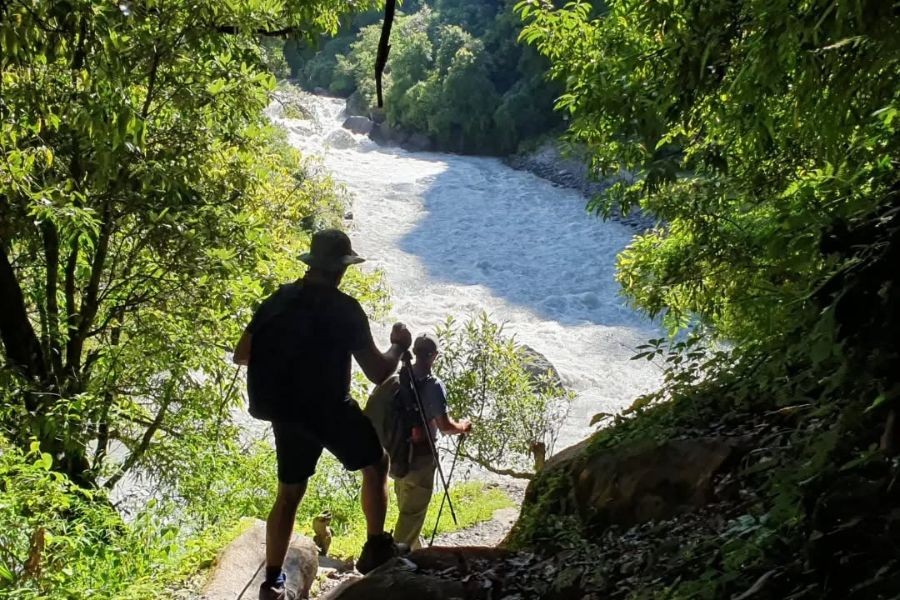
During the monsoon season, some of the single most incredible natural phenomenon occurs in the Langtang area. Wildflowers blanket the alpine meadows in stunning displays of purple, yellow, red, and white, creating natural gardens for miles. Jaw-dropping views of waterfalls will become a constant friend along the trail, with some waterfalls falling thousands of feet in unbelievable displays of nature's power. Forests have a nearly magical ambiance with mist saturating the older trees, creating an enchanting atmosphere that turns every step into a fairy tale.
Langtang Valley Trek in June
June is the beginning of the monsoon season in the Langtang region and is a transitional month between spring and full summer, being the most moist part of the summer. The Langtang Valley trek in June sees only moderate rain, usually in the afternoons and evenings.
Weather Conditions:
- Daytime temperatures: 15-20°C in lower elevations, 5-10°C at higher elevations.
- Night temperatures: 3-8°C at Kyanjin Gompa.
- Rain: Moderate to heavy rain in the afternoon.
- Morning visibility: Generally clear conditions with good mountain views.
June provides some of the finest morning mountain views of the entire summer season. The air is still relatively clear in the mornings prior to midday, around noon, providing a fantastic opportunity to see the sunrise views of Langtang Lirung and Dorje Lakpa and some surrounding peaks. Rhododendron forests are still in partial bloom at higher elevations as spring arrives a little later at higher elevations.
The trails are in good condition early in June with minimal possibility of landslides. Teahouses are fully operational but not yet overcrowded, so accommodations should be comfortable. Overall, June is a great time for trekkers who want to see the beauty of summer, which is typically more stable weather.
- Related article: The Ultimate Guide to Langtang Valley Trek in Autumn
Langtang Valley Trek in July
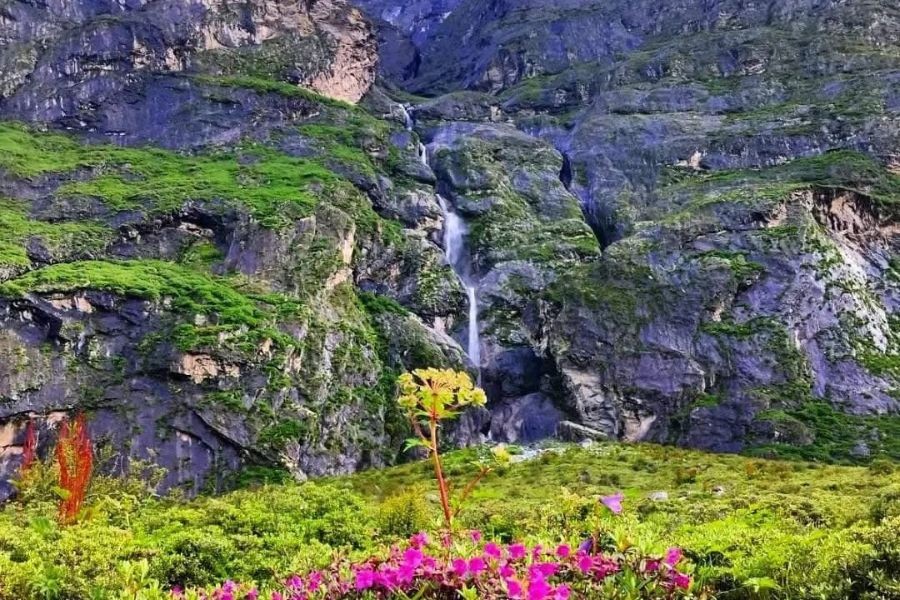
July is the height of the monsoon in the Langtang Valley, marked by the heaviest rain and dramatic changes in the landscape. Planning a Langtang Valley Trek in July requires planning and flexibility. However, for adventurous trekkers, you can have a trip surrounded by incredible natural beauty.
Weather Conditions:
- Daytime Temperatures: 18-22°C in the lower areas, 8-12°C in the Kyanjin Goma.
- Night Temperatures: 5- 10°C in the higher camps.
- Rain: Heavy, generally in afternoon downpours every day.
- Cloud cover: Extensive, with views of the mountains, more consistent in the morning hours.
As this occurs, the valley is once again transformed into a green wearland. The vegetation will be at its peak, giving a jungle-like feel in the lower elevation forests. The waterfalls will multiply by 10 after a hard rain. The wildflower displays will be at their best, with entire hillsides blanketed in blooming alpine species.
In July, trail conditions get more difficult. In forested areas below 3,000 meters, leeches begin to appear and require protection. Some river crossings may become more challenging due to increased flow, but the principal Langtang Valley trail remains open, as local communities will maintain bridges and clear small landslides quickly.
While the peaks may not be visible to the highs of the trekking experience, focus turns to the immediate landscape—the amazing plant life, the power of waterfalls, and the atmospheric feel of mists and clouds swirling about.
Related article: Langtang Valley Trek in Winter: Your Complete Guide to a Magical Himalayan Adventure
Langtang Valley Trek in August
While August usually continues the monsoon pattern, it often begins to be more indicative of summer transitioning toward autumn. The Langtang Valley trek, in August, can experience clearer weather, particularly towards the end of the month, while continuing to display summer lushness.
Weather conditions:
- Day temps 17-21 degrees Celsius at lower elevation, 7-11 degrees at higher altitude.
- Night temps 4-9 degrees Celsius at Kyanjin Gompa.
- Precipitation and rain: moderate to heavy, but can have breaks.
- Visibility conditions: improving, particularly in late August.
In August, there are considerably better chances of clearer afternoon skies when compared to July. The monsoon begins waning in intensity, particularly in the last half of August. Opportunities for better visibility for photography of mountain scenery and views for larger panoramas will occur sporadically at this time.
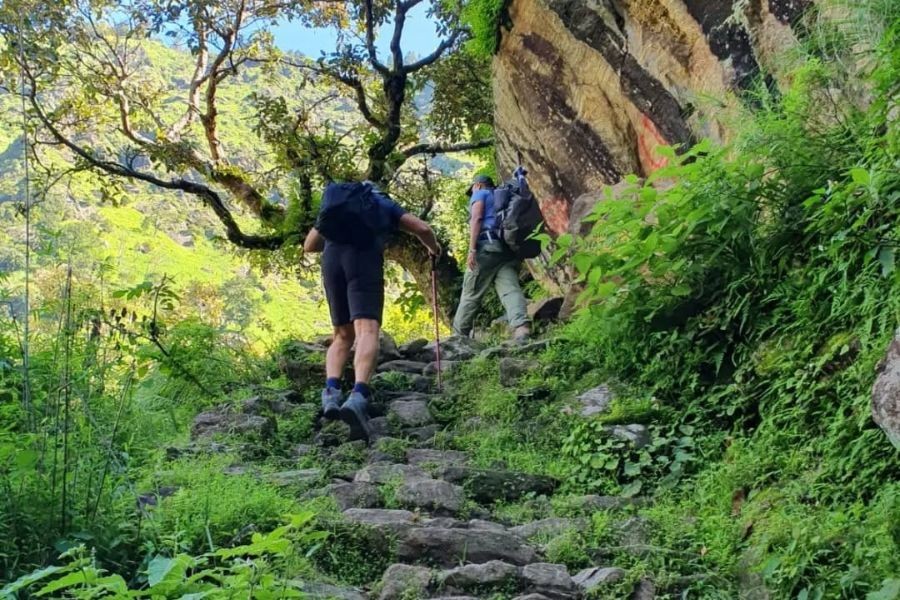
The trails will be lush, but slightly dry out. Activity in mud should reduce as the shipment dries out and will be vastly improved by simply walking on dry ground. Wildflower blooming will continue, but some species are transitioning to bloom for seed formation, and others will have already begun drying or dying.) Waterfalls will maintain their dramatic flows as there are still regular rainfalls occurring that will be connected with glacial melting.
Wildlife viewing is excellent in August. Animals will still be active as summer behavior continues. Specific bird species will remain active, and particularly preparation for autumn migrations will provide optimal wildlife viewing. Forest habitats will remain green and primarily unchanged, but there will also be interesting mushrooms and fungi visual growth in the landscape.
How Difficult is it to Trek in Langtang Valley in the Summer?
The Langtang Valley trek during the summertime has moderate to difficult levels of difficulty. The difficulties encountered generally stem from weather conditions rather than from any technical climbing aspects. Understanding the difficulties will help you prepare properly for your trip.
Physical Difficulty: The basic trek to Kyanjin Gompa is generally moderate in difficulty at any time of the year. You are gaining approximately 3,000 meters over the six to seven-day trip, and you will be trekking every day for about 5-7 hours each day. The trek consists of a gentle ascent, walking in the river valley, and steep sections. There is nothing that requires technical climbing.
Physical difficulty will be heightened during the summer months due to the wet conditions. The wet conditions also make the trails slippery, and you will need to concentrate more to maintain your energy. The muddy sections will also require attention as you must place your feet carefully. At the lower elevation, the humidity will wear you down faster than the dry conditions experienced in the other seasons. You should anticipate another 10-15% energy expenditure than in a regular autumn or spring trekking experience.
Related article: Langtang Valley Trek Difficulty - A Complete Guide for Beginners to Experienced Trekkers
Weather-Related Challenges
- Rain management: Daily afternoon showers require waterproof gear and pack protection
- Visibility limitations: Cloud cover may obscure mountain views during certain hours
- Trail conditions: Mud, wet rocks, and occasional stream crossings need careful navigation
- Temperature fluctuations: Warmth during the day versus cold, damp evenings require layered clothing systems
Technical Issues: The Langtang valley trek does not necessitate mountaineering abilities, but summer conditions may require good hiking skills, and prior experience trekking in different weather conditions will help. River crossings may not be more difficult than in other months, but increased water flow could complicate them even if there are bridges on the main trails.
Altitude Considerations: Altitude is primarily a consideration for all trekkers in all seasons. Kyanjin Gompa is located at 3870m, so acute mountain sickness (AMS) will be a consideration. The summer's weather may actually assist in acclimatization because once the weather is good, there is a likelihood of slower tempos and perhaps extra rest days, minimizing altitude concerns.
General Assessment: In terms of overall fitness levels of the participants in question, the summer Langtang Valley trek is rated among other treks at moderate difficulty. Weather complications are a little bit different during summer than at other times of year, but proper planning and a pleasing demeanor turn these factors into part of the adventure's appeal.
How to Trek Safely in the Summer Occasionally: Trekking in the Langtang Valley during the monsoon season requires some level of preparation and awareness about the risks associated with the monsoon in June, July, and August. The following list of ideas to follow is safety-related ideas we would recommend, and in general, if followed, should ensure a safe and enjoyable process.
Essential Gear and Equipment
To maintain your dry comfort in variable weather, you will want to consider:
- A high-quality rain jacket with taped seams
- Some rain pants or waterproof trousers
- A pack cover or waterproof liner for your backpack
- A waterproof bag for your electronics (e.g., camera, phone) and documents
- Gaiters to help keep water out of your boots
As for your footwear:
- Waterproof hiking boots with sturdy ankle support
- Extra pairs of moisture-wicking socks
- Camp shoes or simple sandals for the teahouse
- You may want to consider packing a boot dryer or having a few extra sheets of newspaper for drying
For your overall clothing system:
- A moisture-wicking base layer
- Insulating mid-layer (e.g., fleece or down)
- Quick-dry trekking pants
- Warm layer for the cold, damp evenings
- Sun protection at times when it is clear in the mornings
Importance of Health and Hygiene
- To protect yourself against leeches, you should wear long pants tucked into your socks when walking through forested areas below 3,000m. Get some insect spray with DEET in it (e.g., Off or Ben's). Also, bring salt or a lighter to help safely remove leeches.
- For purifying drinking water, use a combination of purification tablets, UV pen, and filters, never just boil potentially contaminated water from teahouses.
- For foot care, check your feet every day for blisters and keep them as dry as possible, and have spare socks with you to change into often.
- Your First aid kit should have a solid first aid selection, including blister treatment, pain relievers, anti-diarrheal medication, and altitude sickness treatment.
Safety Measures to Take on the Trail
- Start by trekking on the trail as early as possible (6-7 AM) to give yourself the best chance of clearer weather and to avoid afternoon storms.
- Pay attention to the weather, watch for patterns, and listen to local advice.
- Be aware that in heavy rain, to avoid stopping in landslide-prone areas, listen for odd noises or vibrations that may indicate slope movement.
- Use established bridges when crossing rivers; never cross swollen rivers without local advice on the safety and ability to cross them.
- Be aware of thunderstorm conditions. If you should find yourself in thunderstorms, leave ridgelines as it is not safe to be up high, and don't stay near isolated trees.
Communication and Support
- Keep your trekking agency or lodge keeper informed of your daily plans.
- Bring fully charged power banks for your mobile devices.
- Know emergency contact numbers: Nepal Tourism Board (977-1-4247041), Trekkers' Information Management System.
- Consider satellite communication devices in more remote areas.
- Trek with a licensed guide who is familiar with summer weather conditions.
Acclimatization Protocol
- Follow the typical acclimatization schedule: Lama Hotel (2,380m) to Langtang Village (3,430m) to Kyanjin Gompa (3,870m).
- Plan to have another acclimatization day at Kyanjin Gompa.
- Ascend gradually, using the "climb high, sleep low" principle.
- Drink plenty of fluids (3-4 liters a day).
- Recognize symptoms of AMS (acute mountain sickness): headache, nausea, dizziness, and shortness of breath.
- Descend immediately if symptoms are worsening.
Travel Insurance
Obtain comprehensive travel insurance for:
- Helicopter evacuation from high altitude.
- Medical treatment in Nepal.
- Trip cancellation for reasons such as weather.
- Lost or damaged equipment.
Post Monsoon in the Langtang Valley Trek
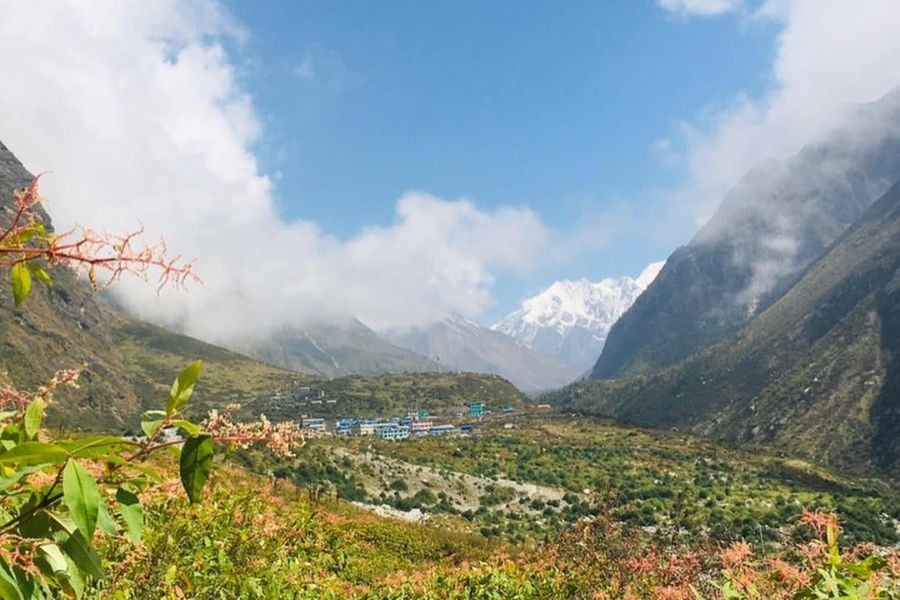
In recent years, there have been notable variances in the transition from monsoon to post-monsoon season in the Langtang region, as seen between 2024 and 2025.
2024 Experience
The post-monsoon season in the Langtang region during 2024 averaged several unique and substantial difficulties even for seasoned trekkers and locals. There was an unusually long monsoon season recorded in September, with significant rainfall lasting well into the month, causing serious problems across the valley all season long.
Multiple landslides blocked parts of the trail (especially between Syabrubesi and Lama Hotel) and meant that extensive work had to be completed on the trail system. Teahouses were flooded in several areas, forcing some to temporarily close and limiting available accommodation in those locations. The river, the Langtang Khola, rose to unsafe levels and washed out several temporary bridges that trekkers had previously crossed. Furthermore, some of the rocky fords became unsafe to cross.
The most disturbing point was the trail conditions between Langtang Village and Kyanjin Gompa. Prolonged rains had undermined all of the hillsides, introducing new landslide areas that never existed in previously climbed areas. Several trekking groups found themselves in quick evacuation situations due to blocked trails and safety concerns. The Nepal Tourism Board published advisories recommending that trekkers postpone their journeys or choose alternate routes.
The late monsoon in 2024 disrupted the traditional October trekking season. The trails remained muddy, unstable, and the mountain views were obscured by clouds. The post-monsoon clarity normally appears in the second week of October, but did not resolve itself until mid-November. There were economic impacts on local communities; the number of visitors was considerably lower than in typical years.
2025 Experience
The 2025 trekking season revealed significant changes for the better, resulting in renewed hope for summer and post-monsoon trekking in Langtang. The monsoon behaved differently in 2024, exhibiting more typical patterns, with the rain fast diminishing from the first week of September and the transition to autumn weather progressing smoothly.
Trail maintenance was significantly improved after the struggles of 2024. The authorities of the Langtang National Park, the national park, and residents studied the vulnerable sections of the trail and reinforced them with permanent drainage and increased the strength of the bridges. These trail improvements should increase resilience to future monsoonal rains in Langtang.
The 2025 post-monsoon season brought excellent trekking conditions in Langtang. Blue sky developed as expected in late September, allowing for incredible views of the mountains. The trails really quickly improved in consistent footing with some muddy areas, but much less than in 2024, throughout the valley. Teahouses that pulled things back together are now repaired, improved, and operating, and the local tourism economy quickly rebounded.
The Langtang area in 2025 was better prepared for seasonal transitions. Early warning systems for landslides and floods were implemented, communication systems improved, and a process was established for emergency response. This means safety margins for summertime and shoulder season trekking are increasing.
Lessons and Recommendations
The difference between 2024 and 2025 reinforces the significance of:
- Keeping up to date with reliable sources regarding current conditions
- Building flexibility into trek itineraries
- Supporting local communities responsible for maintaining trails year-round
- Understanding that climate variability alters traditional seasonal patterns
- Selecting well-established trekking agencies that employ local knowledge and safety protocols
As a conclusion to our summer trekking experiences, these lessons affirm that, although there are uncertainties associated with trekking in the monsoon season, we can have successful and safe adventures with the combination of planning, local support, and the ability to adapt to changing conditions, regardless of season.
Related article: Accommodation on Langtang Valley Trek | Teahouses, Lodges & Homestays
FAQs
Is it safe to trek in Langtang Valley in the summer?
Yes, the Langtang Valley trek is safe in the summer if you plan well. While summer monsoon conditions mean some rain and sometimes challenging trail conditions, the main trail is kept open and in good condition. Trek with experienced guides, carry the proper gear, check the weather, and you will have a safe experience.
What should I pack for the Langtang Valley trek in year in the summer?
Important items are a waterproof rain jacket and pants, waterproof hiking boots of decent quality, a pack cover, moisture-wicking clothes, warm layers for the evening, sun protection items, leech prevention items, first aid, a water purification system, and a headlamp. Pack light, but try to cover yourself from the weather.
Will I see mountains during the Langtang Valley trek in July and August?
Yes, visibility will not be as good as when not during monsoon, but yes, you will get views of the mountains, although visibility will vary. Usually, mornings are the clearest time, and you can see the mountains from camp, often until around late morning, when they tend to cloud in to some extent. Toward the end of August, you often get better visibility than in July. Nonetheless, even when the peaks are hidden behind the clouds, there is a lot of dramatic landscape and waterfalls, and lush valleys that will provide a spectacular setting, regardless.
Are teahouses open during the summer in Langtang Valley?
Yes, the teahouses situated along the main Langtang Valley trail operate for most of the summer. While some higher elevation facilities may provide fewer services than in the peak season, between Syabrubesi and Kyanjin Gompa, you will find sufficient accommodation and meals available. I recommend booking in advance through trekking agencies.
What do I do about leeches on the trail?
Leeches will be present in forested areas below 3,000 meters during the monsoon. You can avoid leeches by wearing long trousers tucked into socks, applying boots and lower legs with DEET-based repellent, or by using salt or tobacco to get rid of any leeches that first attach. A leech bite isn't harmful, but it can bleed a great deal because of the anticoagulants in its saliva.
What is the best month for the Langtang Valley trek in summer?
In June, you will have the best combination of adequate rainfall, manageable trail conditions, and views in the morning. August, especially late August, will show improving weather as the monsoon makes way for early autumn. July will deliver the wettest conditions, but with the most dynamic waterfalls and overall greenery for those who enjoy nature but can tolerate the rain.
Conclusion
Trekking the Langtang Valley in summer gives adventurous trekkers a totally different experience in the Himalayas compared to the established peak tourist seasons. Although trekking the Langtang Valley in June, July, and August has its unique considerations to navigate monsoon weather, it rewards trekkers with stunning waterfalls, colorful wildflowers, lush green valleys, and the tranquility of being on less-traveled trails without the crowds.
With proper preparation—high-quality waterproof equipment, flexible itineraries, and positive attitudes—trekking in the Langtang in summer will be an extraordinary experience. Whether you choose to trek in June for transitional conditions, July for the maximum intensity of greens, or August for the gradual return to improved weather, this remarkable valley will reward your spirit of adventure like never before in the form of memories and experiences that are inaccessible in any other months of the year. Prepare properly, trek safely, and embrace this season with the unique magic that only summer monsoons can bring to the incredibly unique environment that is the Himalayas.
Inquire Now: [email protected]
Expert Consultation: WhatsApp: +977 9851006023 (Bikesh)
.jpg)
